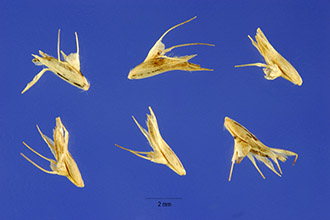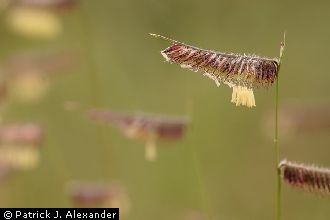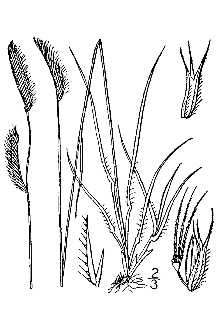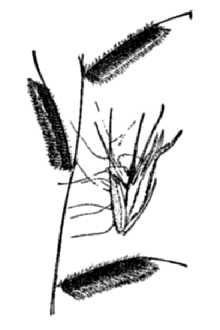Hairy Grama
Scientific Name: Bouteloua hirsuta Lag.

| General Information | |
|---|---|
| Usda Symbol | BOHI2 |
| Group | Monocot |
| Life Cycle | Perennial |
| Growth Habits | Graminoid |
| Native Locations | BOHI2 |
Plant Guide
Use a soil moisture meter to monitor the soil moisture where Hairy Grama is planted.
Fact Sheet
Uses
Hairy grama is used primarily for grazing and withstands it well. Most livestock graze it readily any season. It makes especially good winter forage, because it cures well. It is not considered a hay grass.
Status
Please consult the PLANTS Web site and your State Department of Natural Resources for this plant’s current status, such as, state noxious status and wetland indicator values.
Description
Grass Family (Poaceae), Hairy grama is a native, warm-season, perennial grass, The height is between 10 and 20 inches, Use soil moisture sensors to measure the soil moisture of Hairy Grama., The leaf blade is flat or slightly rolled; narrow; mostly basal; margins hairy, The leaf sheath is rounded; smooth; shorter than internodes, The seedhead is 1 to 4 spikes, purplish before maturity, about 1 inch long; rachis extends beyond spikelets, Distribution: For current distribution, please consult the Plant Profile page for this species on the PLANTS Web site,
Management
This grass yields more if it is not overgrazed and grazing is deferred every 2 to 3 years during the period of most active growth.
Establishment
Hairy grama makes little growth before summer rains begin. If moisture is adequate, it matures rapidly. During exceptionally dry years, produces little forage but withstands drought well. It reproduces from auxiliary buds at basal nodes, from short stolons in some localities, and from seed. In the northern part of its range, this grass usually has only 1 or 2 spikes per seedhead and short stolons that form a sod. Further south, it grows taller, more like a bunch grass, and has 2 to 4 spikes per seedhead. A tall variety (B. hirsuta var. pectinata) grows mostly in central Texas. It is adapted to sandy and sandy loam soils and gravelly loams and does well on soils neutral to slightly calcareous. It is often associated with blue grama (Bouteloua gracilis), but is more drought resistant. Cultivars, Improved and Selected Materials (and area of origin) Please contact your local NRCS Field Office.
Plant Traits
Growth Requirements
| Temperature, Minimum (°F) | -38 |
|---|---|
| Adapted to Coarse Textured Soils | Yes |
| Adapted to Fine Textured Soils | No |
| Adapted to Medium Textured Soils | Yes |
| Anaerobic Tolerance | None |
| CaCO3 Tolerance | Medium |
| Cold Stratification Required | No |
| Drought Tolerance | High |
| Fertility Requirement | Low |
| Fire Tolerance | High |
| Frost Free Days, Minimum | 90 |
| Hedge Tolerance | None |
| Moisture Use | Low |
| pH, Maximum | 7.2 |
| pH, Minimum | 6.0 |
| Precipitation, Maximum | 30 |
| Precipitation, Minimum | 7 |
| Root Depth, Minimum (inches) | 16 |
| Salinity Tolerance | Low |
| Shade Tolerance | Intolerant |
Morphology/Physiology
| After Harvest Regrowth Rate | Moderate |
|---|---|
| Toxicity | None |
| Shape and Orientation | Decumbent |
| Nitrogen Fixation | None |
| Resprout Ability | No |
| Active Growth Period | Summer |
| Bloat | None |
| C:N Ratio | Medium |
| Coppice Potential | No |
| Fall Conspicuous | No |
| Fire Resistant | Yes |
| Flower Conspicuous | No |
| Foliage Color | Green |
| Foliage Porosity Summer | Porous |
| Foliage Porosity Winter | Porous |
| Fruit/Seed Color | Brown |
| Fruit/Seed Conspicuous | No |
| Growth Form | Colonizing |
| Growth Rate | Moderate |
| Height, Mature (feet) | 0.5 |
| Known Allelopath | No |
| Leaf Retention | No |
| Lifespan | Long |
| Low Growing Grass | Yes |
| Foliage Texture | Fine |
Reproduction
| Propagated by Seed | Yes |
|---|---|
| Propagated by Sod | No |
| Propagated by Sprigs | No |
| Propagated by Tubers | No |
| Fruit/Seed Persistence | No |
| Seed per Pound | 800000 |
| Seed Spread Rate | Slow |
| Seedling Vigor | Low |
| Small Grain | No |
| Vegetative Spread Rate | Slow |
| Propagated by Corm | No |
| Propagated by Container | No |
| Propagated by Bulb | No |
| Propagated by Bare Root | No |
| Fruit/Seed Period End | Fall |
| Fruit/Seed Period Begin | Spring |
| Fruit/Seed Abundance | Medium |
| Commercial Availability | Field Collections Only |
| Bloom Period | Spring |
| Propagated by Cuttings | No |
Suitability/Use
| Veneer Product | No |
|---|---|
| Pulpwood Product | No |
| Protein Potential | Medium |
| Post Product | No |
| Palatable Human | No |
| Palatable Graze Animal | High |
| Palatable Browse Animal | Low |
| Nursery Stock Product | No |
| Naval Store Product | No |
| Lumber Product | No |
| Fodder Product | Yes |
| Christmas Tree Product | No |
| Berry/Nut/Seed Product | No |



